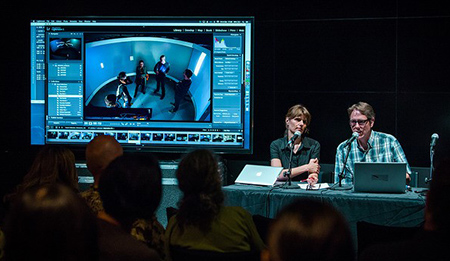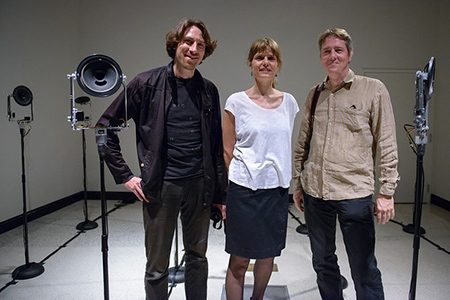
UC San Diego Professor Appointed Composer-in-Residence at Qualcomm Institute
By:
- Dirk Sutro
- Doug Ramsey
Media Contact:
- Dirk Sutro - dsutro@ucsd.edu
- Doug Ramsey - dramsey@ucsd.edu
Published Date
By:
- Dirk Sutro
- Doug Ramsey
Share This:
Article Content

Composer Katharina Rosenberger (left) and Jan Schacher of Zurich University of the Arts discussed a multimedia installation at Qualcomm Institute’s IDEAS event last year. Photo courtesy Qualcomm Institute
Composer and multimedia artist Katharina Rosenberger, a professor in the Department of Music at the University of California San Diego, has been appointed composer-in-residence at the Qualcomm Institute (QI), the UC San Diego division of the California Institute for Telecommunications and Information Technology (Calit2). Rosenberger is the fourth UC San Diego music faculty member to hold the position following Roger Reynolds (2007-2010), Rand Steiger (2010-2013) and Lei Liang (2013-2016). Her recent composition, “tempi agitati,” will be performed Thursday, Dec. 8 at UC San Diego’s Conrad Prebys Concert Hall, by the contemporary vocal quartet, Neue Vocalsolisten.
“We are delighted to welcome Professor Rosenberger to the institute, where we are always looking for ways to push boundaries at the intersection of the arts and technology,” said Qualcomm Institute Director Ramesh Rao, a professor of electrical and computer engineering in the Jacobs School of Engineering. “Each of our previous composers-in-residence reached out to different sets of collaborators, resulting in remarkable works that are exemplars of interdisciplinary research, and we now look to Katharina to put her own mark on the institute.”
The residency is jointly supported by the Qualcomm Institute, the Department of Music and the Division of Arts and Humanities at UC San Diego. Cristina Della Coletta, dean of the Division of Arts and Humanities, places the intersection of arts and technology high on her list of priorities.
“UC San Diego knows that while technology is changing arts-based practices, the arts concurrently have a primary place in imagining and shaping the increasingly technologized world we live in,” noted Della Coletta.
Given that much of Rosenberger’s work manifests in an interdisciplinary context, the composer and artist expects to collaborate with neuroscientists, engineers, software developers and other technologists.
“The appointment gives me the tools and people that I need to develop new work,” Rosenberger said. “I want to partner with a neuroscientist and I will use the institute’s Audio Spatialization Lab to experiment with near-field and far-field sound.”

Katharina Rosenberger (center), pictured with artist-musician-researchers Daniel Bisig (left) and Jan Schacher (right) from the Institute of Computer Music and Sound Technology at the Zurich University of the Arts, hosted a presentation of “Aggregat,” a kinetic multi-channel sound installation at Qualcomm Institute’s IDEAS series in 2015. Photo courtesy Qualcomm Institute
Currently, Rosenberger is developing a project that will use elements including electroencephalogram (EEG) scans of her own brain to create multisensory installations. In preliminary research, she has been drawn to architectural shapes generated by interactive visualization tools. Some of these resemble organic forms found in nature or in experimental architecture.
“I also want to find ways to make my installations interactive, so that the responses of visitors influence the environments,” said Rosenberger, who is no stranger to the intersection of music and technology since several of her earlier works have utilized scientific elements.
Although Rosenberger’s compositions are sometimes performed in concert halls, she often chooses architectural spaces. Her interactive sound and video installation VIVA VOCE was presented in subterranean vaults at the Reservoir in Berlin-Prenzlauer Berg, Germany. Meanwhile, the nocturnal performance “madrigali notturni” premiered at the Arne-Jacobsen-Foyer, a two-story glass construction divided by a suspended gallery at the Herrenhausen Castle in Hanover, Germany. Singers’ voices echoed in reverberant spaces as they carried candles and moved through colored pools of light. At various points, confetti floated down to produce glittering clouds and flurries of sound.
Rosenberger grew up in Switzerland playing piano, singing and composing short pieces. She studied jazz at the Berklee College of Music in Boston and filmmaking at the Massachusetts College of Art and Design. Subsequently she attended Columbia University, where she earned a Doctor of Musical Arts degree in 2008, and joined UC San Diego’s music faculty the same year.
The new appointment is not Rosenberger’s first project with the Qualcomm Institute. Since 2010, she has participated in workshops, artist discussions and worked with visiting teams of computer music and sound technicians at the institute. The two-year appointment is also not her first residency. In 2012, she was composer-in-residence at the Institute for Computer Music and Sound Technology/ZHdK, Zurich, Switzerland; in 2007, at the Centre National de Création Musicale (GMEM) in Marseille; and in 2005, with France’s Orchestre de Nimes.
Share This:
You May Also Like
Stay in the Know
Keep up with all the latest from UC San Diego. Subscribe to the newsletter today.


